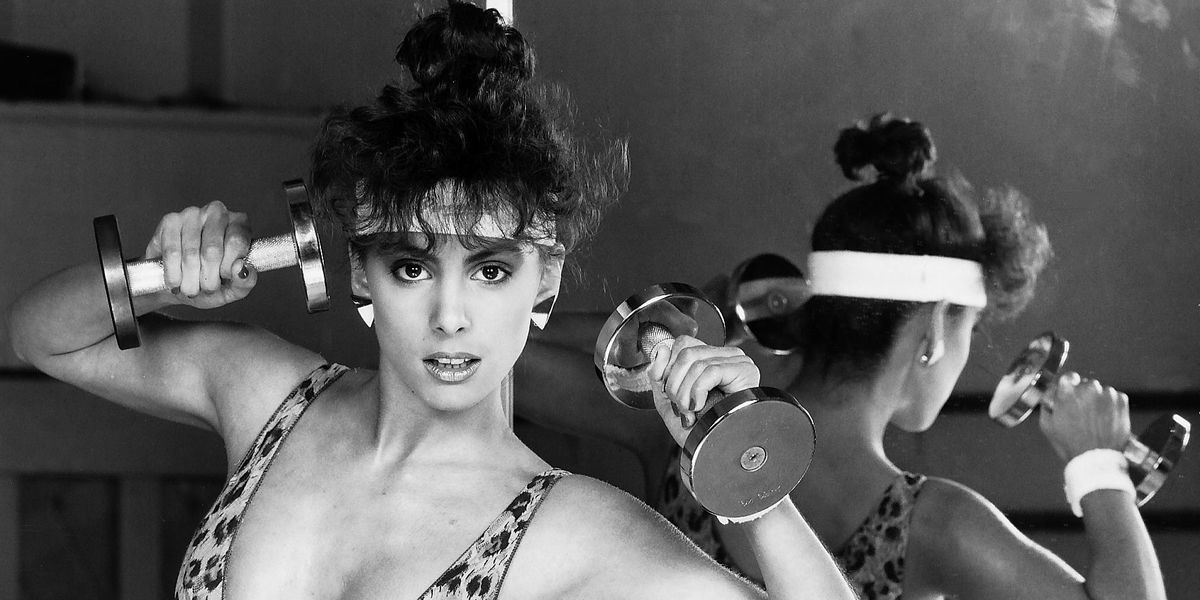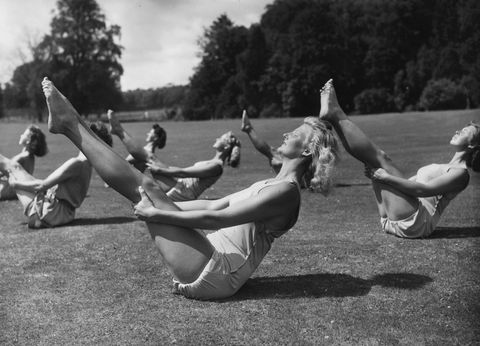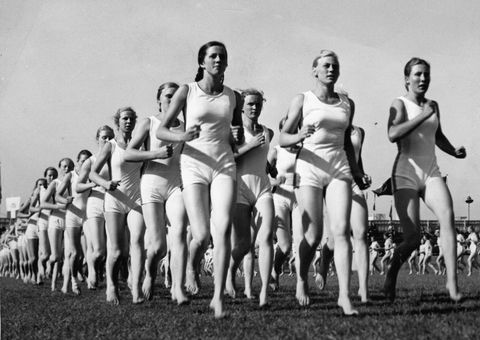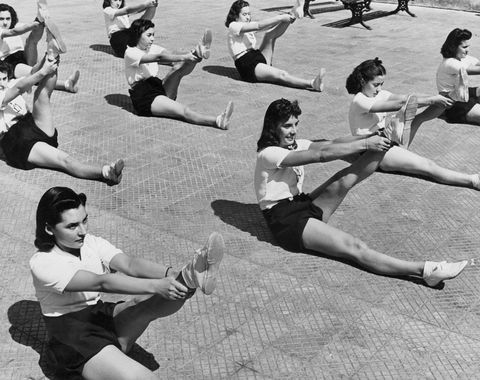Before the pandemic, Kristen Wilson, 33, was a reluctant gym-goer whose discomfort in fitness environments caused years of unpleasant experiences. In group classes, she’d push herself to the point of pain, overextending because she didn’t want to look out of place among the workout zealots beside her. “Even yoga, which is supposed to be relaxing, was always so stressful for me,” Wilson, who lives in New Jersey, says, recalling the dread she’d feel walking into a class. “I’ve tried different gyms, different times of day, different methods. I was never focused on me. I was always focused on how my body was being perceived.”
When studios and gyms around the country abruptly closed during the early days of lockdown, fitness became a solitary pursuit. The industry hurried to virtualize, modifying its offerings so that people could take “no days off” at home. The dumbbell market alone is on track to increase by $272 million by 2024, thanks to hoards of committed fitness enthusiasts stocking their basements, garages, bedrooms, even their small condo living rooms with equipment, causing a months-long shortage. ICON Fitness, which owns Nordictrack, Proform, and iFit, reported a 600 percent increase in sales, attributed to purchases made for at-home workouts. By May 2020, the stock price of Peloton had nearly doubled and the company’s revenue had increased by 66 percent. (The company’s most recent quarterly earnings report showed a 128 percent increase in revenue, compared to the same quarter last year, to more than $1 billion.)
The at-home rendering of fitness, while bemoaned by those who enjoy the competitive atmosphere of group settings, has created an opportunity to think about fitness as an individual practice, without the fixation on comparisons. For people like Wilson, this means a new lease on exercise. “Movement was always closely connected to changing my body,” says Wilson, who is in recovery from an eating disorder. The shift to online classes, which allow her to turn her camera off, has allowed her to feel more comfortable working out. That dread she felt has been replaced by a sense of healthy satisfaction and pride in herself. “With everything online I have the ability to [take classes] in my house and not feel weird and preoccupied with what everyone else is doing,” she says. “I dont have my eating disorder brain taking over.”
By May 2020, Gold’s Gym had filed for chapter 11 bankruptcy protection. Many other facilities closed as months went on due to measures that restricted the number of people allowed inside and the amount of time they’re permitted to stay, essentially adding even more rules to the already rigid regulations of gym culture. In a recent Instagram post, pilates instructor Heather Andersen wrote that her company, New York Pilates, was forced to lay off nearly 100 employees due to the ban on group fitness classes during the pandemic. According to data cited by the International Health, Racquet & Sportsclub Association in a report on COVID’s effects on the industry, 17 percent of U.S. fitness clubs and studios permanently closed as of the end of last year. Those who’ve tried to maintain a familiar sense of pre-COVID convention did so at their own risk. A popular Canadian spin studio became the site of a major COVID outbreak last fall despite taking precautions. It’s estimated that at least 80 people contracted COVID following a class reportedly attended by an asymptomatic patient zero.
As fascinating as it is to watch fitness culture hang on for dear life as its adherents transition to doing jumping jacks in their kitchens and planking on their balconies, it is undeniable that a grand recalibration of how, where, why, and to what extent people exercise is taking hold. That recalibration isn’t just contained to the devout, but those who see this murky moratorium as an opportunity to reconsider their overall ethos around health and wellness. The delineation between the “fit” and the “not fit” has never been less clear. Fitness belongs to no one now. Many have cancelled or paused their gym memberships. People have gained weight. It feels like everyone, at some point in quarantine, embraced baking as a coping strategy—the most popular recipe-related Google searches in March and April 2020 included banana bread, pancakes, brownies, crepes, French toast and cheesecake, according to CNBC. (Not everyone is pro-dessert. A Baltimore doctor recently posted a Twitter thread criticizing Krispy Kreme’s offer of free donuts for vaccinated customers.)
A consistent gym-going friend told me recently that he gave himself permission to not exercise last April in an effort to be more humane with himself. He hasn’t worked out since. I’d be lying if I said the exercise bike I crammed into my kitchen months ago has gotten the use I envisioned when I paid $650—plus delivery—for it. (I suspect that some of those dumbbells and Pelotons have met similar fates.)
At the same time, trainers and practitioners who identify their bodies as non-conforming to mainstream fitness standards have, like others in the fitness realm, moved their offerings online, allowing newcomers like Wilson who previously felt intimidated or unwelcome in gyms to add movement to their lives.
“I tend to see more people who are reclaiming movement as their own, even moving away from terms like ‘exercise’ and toward terms like ‘joyful movement,’ reframing movement as something you do for yourself, and not as atonement,” says Toronto-based yoga practitioner Shannon Kaneshige, whose website notes that their classes are fat-positive and no diet talk is allowed. Since lockdown measures were implemented in March 2020, Kaneshige has seen more straight-size participants joining their classes, a trend they suspect is related to the rejection of weight loss as a reason to attend.
“Given the opportunity, folks will gravitate toward movement that reinforces who they are and who they want to be, and most people don’t want to be miserable,” says Kaneshige. “They don’t want to be competing all the time…I think a lot of the movement away from fitness culture ideology is really just people returning to themselves.”
Reducing the stakes of fitness has squashed the uncompromising expectations of who—and what—exercise is for. Without this pressure, people are free to explore what fitness might mean to them outside restrictive binaries. In the Before Times, the notion of fitness was precarious, a house of cards that could topple with one missed workout or a bite of a demonized dessert. But the tyranny of fitness is entrenched in fear of how others will judge us for not obeying the rules. And with the cult of fitness now decentralized, those rules lose their power. You might say the cult of fitness is in its flop era.
“In the midst of a global crisis, it just feels like we should be finding opportunities for joy, rather than punishing ourselves,” says Philadelphia-based personal trainer and fitness instructor Lauren Leavell. “Maybe barre is too much, maybe people just want to walk their dog. And that’s fine. People have become more intuitive about the ways they’re moving.”
Leavell believes a lasting change is settling in as people realize they have options beyond conventional fitness settings. And, she says, our priorities are undergoing an honest rethink. “People are dying. People are losing their jobs. People are losing their houses. The mindset that would allow someone to say, even in a joking way, that they’re worried about the way their body looks while people are trying to survive is rooted in fatphobia.”
Leavell tells her clients that they’re welcome to keep their cameras off during Zoom classes, which allows them to exercise without feeling watched. “I give my class permission to show up however they are…That freedom makes fitness more appealing to people. They don’t feel locked in.”
While many online fitness instructors are reporting record attendance, especially in lower intensity classes, Leavell says people seem to be more forgiving with themselves for skipping workouts, too. “You don’t have to work out if you don’t want to,” she says. “It’s okay to not work out.”
The stress of living through a pandemic is something Kaneshige sees as a factor in overturning rigid fitness ideology. While many are using exercise as a way to reduce anxiety, just as many are not exercising as a gesture of amity toward themselves.
“It’s a pandemic,” says Kaneshige. “We need to take care of ourselves, and sometimes taking care of ourselves means resting. Sometimes taking care of ourselves means that we let go of society’s expectations, especially when those aren’t in any way based on our own personal wellbeing.”
As pandemic restrictions ramped up, so did membership to the at-home fitness platform Obé, which offers on-demand workouts and 22 live classes daily, led by various high-energy fitness gurus. The app has consistently seen at least a 30 percent membership increase per month since it launched in 2018, with spikes of 80 percent between March and May of 2020, according to a statement from the company. One might view Obé as the closest they’ll get to a normal fitness class experience within the confines of COVID—in a September segment of makeup artist Gucci Westman’s YouTube series, Kate Hudson declared that she owed her abs to the platform—but it too has been reimagined with an evolving ethos in mind.
Obé offers ten-minute classes, in addition to other time lengths, intended for members whose schedules or caregiving obligations do not allow them to dedicate a significant block of time to working out, and for people who just don’t feel like committing themselves to an hour of sweating.
“Some movement is better than no movement,” says Obé co-founder Ashley Mills. “Our job is to fit into people’s lives…That old attitude of owning every minute is an arcane idea, and that kind of indoctrination actually does more harm than good. We’re trying to encourage people to do what their bodies were made to do. You don’t always need to be training for a marathon.”
Mark Mullett, who co-founded Obé with Mills, says that the platform’s programming is meant to accommodate a changing view of how fitness is prioritized. People want convenience and are less willing to give up their entire evenings for exercise. “It’s so different from this idea of driving 20 minutes to the gym, getting undressed, getting redressed, working out for an hour, wondering what to lift and what to do, going back to the shower, getting changed again and going back to the car,” he says.
For Kevin Naulls, a 35-year-old media producer (and a friend of mine) based in Toronto, the last year has ushered in a new gentleness. “When I used to work at the office, it was easy for me to fall into patterns of prolonged agony—I wouldn’t listen to my body as much, but now I listen to it the most,” he says. “I take movement breaks regularly, which equates to setting aside 15 minutes every hour to do some kind of activity, whether it’s doing a lap around the block or doing a cycle of stretches that target my neck, shoulders, and upper back. Before the pandemic, these were never prioritized as parts of my day.”
Importantly, Naulls—who admits missing the space afforded by the gym—now moves for his own sake, to ease issues related to chronic pain, and not because he feels beholden to merciless body standards. “I grew up the fat kid, which is what every hot celebrity says, but in my case it’s true. My weight has been a series of ups and down, mostly fueled by emotional eating to suppress my more depressive and anxious moments,” he says. “I’ve learned since March that fitness doesn’t have to be about reducing so-called problem areas. What I expect from my body now is simple: pain reduction, however that may come, better posture and to feel good.”
Shana Minei Spence, a registered dietitian and nutritionist based in New York City, says that while a shift is occurring, clients still frequently come to her feeling guilty about emotional eating. “That kind of thinking is hard to undo,” she says. “We’ve been taught since a really young age to categorize foods.”
Though it takes more than one session, Spence, whose framework steers clear of diets, says she sees clients eventually adapting their thought processes. “People are slowly starting to put things into perspective,” she says. “It’s a blessing to be alive right now. People are catching this virus and not coming back from it. We’ve all known someone at this point who has had it. Is weight gain really the worst thing that can come from this? There’s a lot more going on in the world than you gaining 10 pounds.”
This content is created and maintained by a third party, and imported onto this page to help users provide their email addresses. You may be able to find more information about this and similar content at piano.io



